How Black Hat Link Building Will Destroy Your SEO
-

Aaron Gray
- Blogs
-
 September 12 , 2022
September 12 , 2022 -
 12 min read
12 min read
“Black hat” refers to the villain of a novel, play or criminal in real life. The term dates back to the early 1900s when villains in Western shows and movies typically wore black hats. From the menacing guy at the end of “The Great Train Robbery” to the first season of “Westworld,” black hats have had this symbolism for over a century.

Somehow, the term found its way into computers and, eventually, search engine optimisation (SEO), with its meaning mostly intact. In this context, “black hat” refers to methods or practices that infringe on a search engines’ terms of service—notably Google’s. Get caught red-handed and your website will suffer all sorts of penalties, from ranking drops to deindexing.
In this blog we’ll delve deeper into black hat link building and its various practices. We’ll also discuss why your overall SEO strategy should steer clear of them no matter what. Let’s look closer.
How Black Hat Link Building Will Destroy Your SEO and Website
- 1) Google Penalties: As far as manually-delivered penalties go, they can affect either parts of the website or the whole domain. Naturally, you don’t want the latter, as it’ll mean the search engine will hit every page with the worst-case scenario. Google penalties are given when you don’t follow their guidelines which are based off previous algorithm changes.So how does Google slap penalties on offending websites? It does this by employing a combination of updates to its search engine algorithm and a panel of human reviewers. A website’s black hat practices can either activate the algorithm trap or get discovered by human monitors, sometimes both.Google notifies website administrators through the Google Search Console for manual penalties, an online toolbox that tracks a website’s SEO performance. If the notification comes from a human monitor, the administrator can file a Reconsideration Request once the issue is resolved. Unfortunately, a penalty delivered by the algorithm can be harder to remove.

- 2) Ranking Drops: Website owners fear rank drops more than anything else and for good reason. Ranking drops generally coincide with Google algorithm updates or penalties. As you can see from this screenshot below the organic traffic of this website dropped dramatically when a core update occurred. The key to getting your site off the ground again is by doing a full analysis of your website against the type of algorithm that was released.

- 3) Removal from SERPs: Deindexing is worse, as it removes the website—in its entirety—from the search engine index. Searching for the website through keywords on Google will be extremely hard, if not impossible. Google reserves this action for grave violations like posting hate speeches or publishing customers’ personal information without consent. You can check if you’ve been deindexed by searching site: website domain into google search. If no search results come up, you’ve been deindexed. This is an example of a fake website.

- 4) Suspension of Google Business Profile: SEO violations can also get a business’s Google Business Profile suspended, and Google doesn’t disclose the reason. Experts can only advise business owners to review Google’s guidelines and try to recall what they did before getting penalized. Regardless, black hat link building practices will no doubt get any business’s profile suspended.

- 5) Poor User Experience: Black hat techniques can also cause poor user experience. This is due to spammy links, redirects to non-relevant websites, hard to read content, keyword stuffing and other techniques. Here’s an example of a poorly written piece of content.

Black Hat Link Building: What Not To Do And Why
One fundamental rule in SEO is never, ever test Google’s patience. If we look at the graph we used earlier, this drop coincided with a major google update.

Terrifying, isn’t it?
Within a year of rolling out several updates (namely the infamous Panda and Penguin), domain visibility across the web took a nosedive.
If you don’t want this to become a reality for your website create a link building strategy and avoid the following black hat link building methods:
- 1. Low-Quality Backlinks. Backlinks are the bread and butter of link building. By getting a website to link back to your webpage, search engines will see it as others vouching for your credibility. They become more valuable if the referrals come from websites with high domain authority. For example, here’s a credible domain linking to another blog.
 That said, backlinks from such domains won’t matter if they’re a mismatch for your content. Why ask for a backlink to your fashion article from a website that talks mainly about SEO? It’s like trying to buy fabric at a computer store.
That said, backlinks from such domains won’t matter if they’re a mismatch for your content. Why ask for a backlink to your fashion article from a website that talks mainly about SEO? It’s like trying to buy fabric at a computer store.
Sadly, some won’t mind getting backlinks from mismatched domains, as long as they’re still backlinks. These low-quality backlinks can do more harm than good. They can throw keyword campaigns into disarray because they succeed in irrelevant keywords but fail in more crucial ones.
Irrelevance isn’t the only thing that produces low-quality backlinks. SEO professionals advise against using:
- Forum/comment links
- Social bookmark links
- Directory submission links
- Links from link-mill and PBN domains
- Links generated automatically
These are just some examples of poor-quality link types.
- 2. Poorly-Written Blog Posts For this black hat practice, look at the table below.
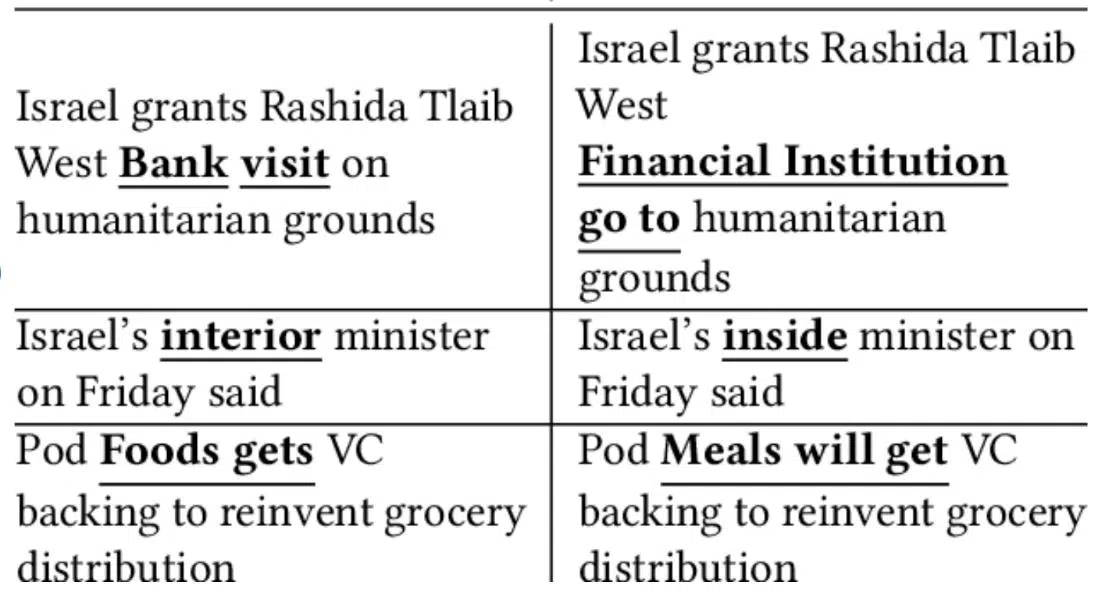 This table from a whitepaper published at ResearchGate explains (albeit indirectly) why spun articles are a problem. Imagine you’re a resident of the West Bank, only for that article to mistake “Bank” for a place to withdraw or deposit cash. On another note, imagine you’re the owner of Pod Foods, only to see that it completely changed your business’s registered name.
This table from a whitepaper published at ResearchGate explains (albeit indirectly) why spun articles are a problem. Imagine you’re a resident of the West Bank, only for that article to mistake “Bank” for a place to withdraw or deposit cash. On another note, imagine you’re the owner of Pod Foods, only to see that it completely changed your business’s registered name.
Article spinning yields grossly inaccurate content, which can result in loads of trouble—not just on the SEO front. People won’t take you seriously, especially if the sentences barely make sense. Not only will readers not share it with their friends or followers, but Google will eventually find out and penalise your domain for it.
It isn’t just spinning that’ll land you in hot water. Google has a 167-page rulebook for content quality checking, and any violations of the stated rules are enough to flag a post as low quality, if not spammy. In a nutshell, below are several red flags.
- An unsatisfactory amount of main content
- Exaggerated or shocking main content
- Ads that they’re distracting
- The author has a negative reputation
- Bare-bones content for a “Your Money, Your Life” (YMYL) webpage
- Inadequacies in expertise, authoritativeness, and trustworthiness (EAT)
These are just some of the main rules when it comes to content.
- 3. Private Blog Networks (PBNs) Here’s a story. Back in the early years of SEO, one of NO-BS’ managing partners, Aaron, used to build and manage PBNs, but thankfully not anymore. You can read the story on the blog landing page.
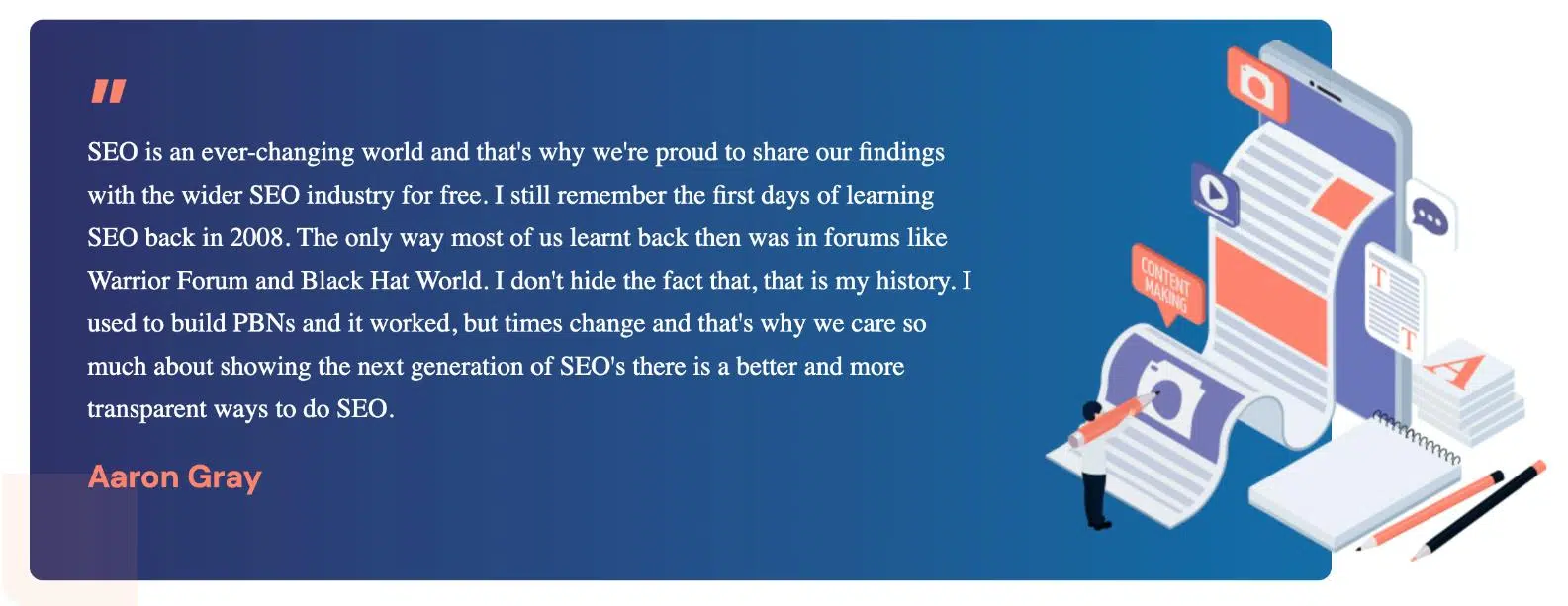
What’s a PBN, you ask?
It’s essentially a network of websites that post content with backlinks to a single primary domain. The usual setup involves buying many expired domains and repurposing them to publish content with backlinks. Before Google doubled down on most black hat practices, PBNs were among the most effective link building methods. Here’s an example of a PBN. Its telltale signs are only having a home page, write for us page, contact page and it mentions PBN hosting. It was made to post blogs on it.
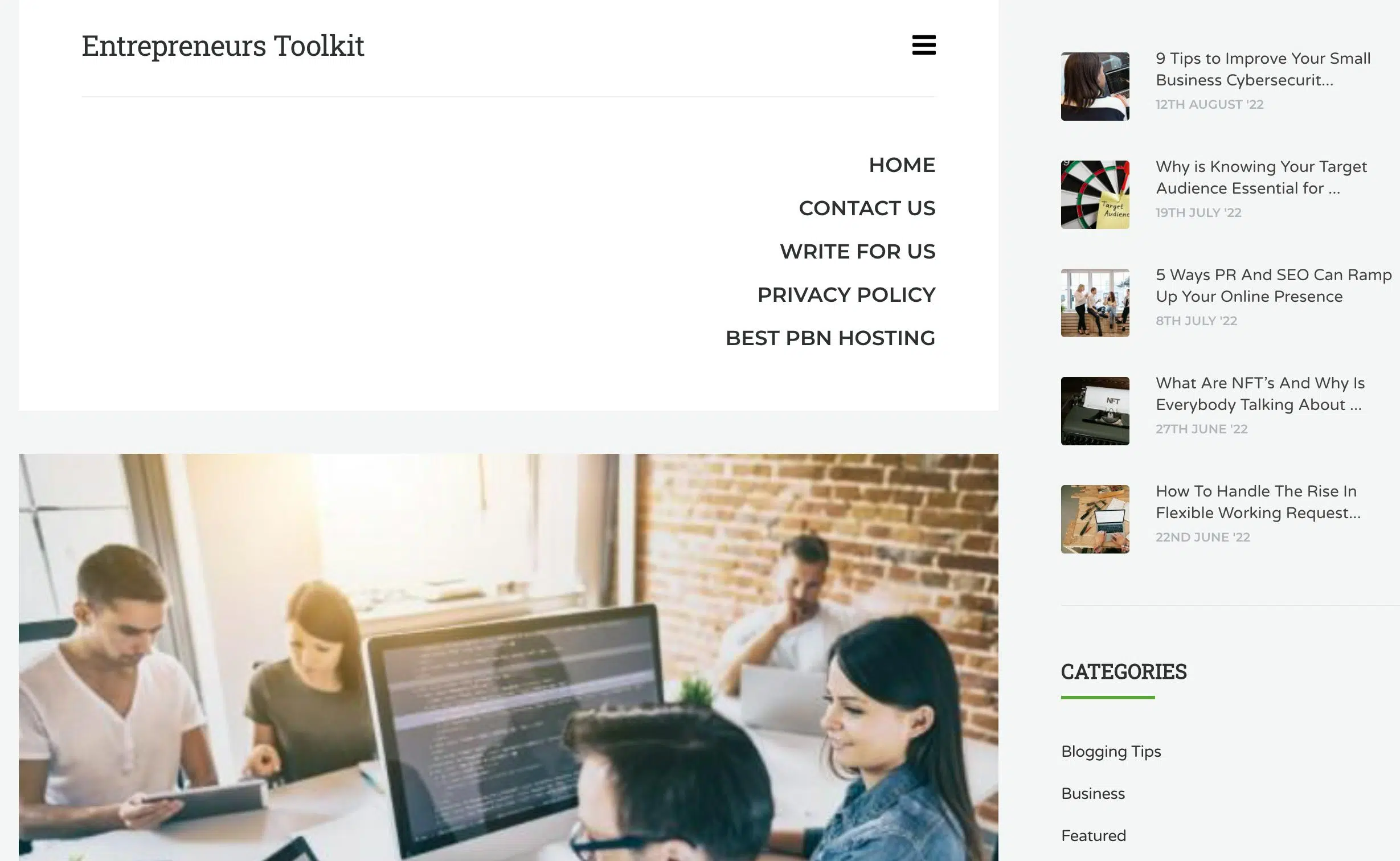
So, what happened? Why is building a PBN a black hat technique now?
JCPenney happened.
In 2011, The New York Times published a special report that uncovered the multibillion-dollar fashion brand’s PBN. Here’s an excerpt.
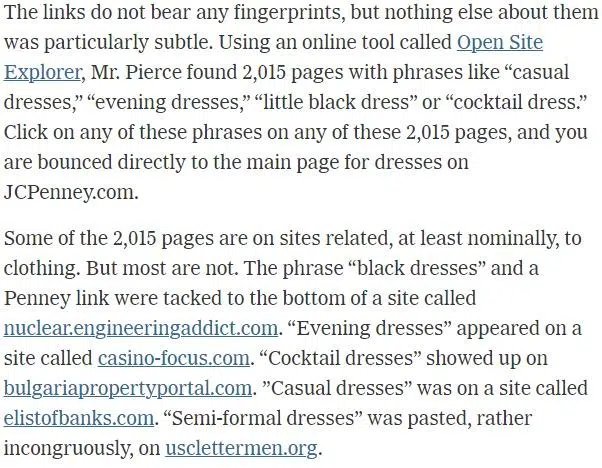
Going back to the matter of irrelevance earlier, what does a domain that purportedly posts content on nuclear engineering have to do with black dresses? What’s up with a website on properties for sale in Bulgaria posting content on cocktail dresses?
Google dislikes PBNs for the reason that they produce unnatural backlinks. For instance, a PBN website shares the same IP address as hundreds of others. Using SpyOnWeb.com look at how many links share an IP address with casino-focus.com. This is just 40 of 98.
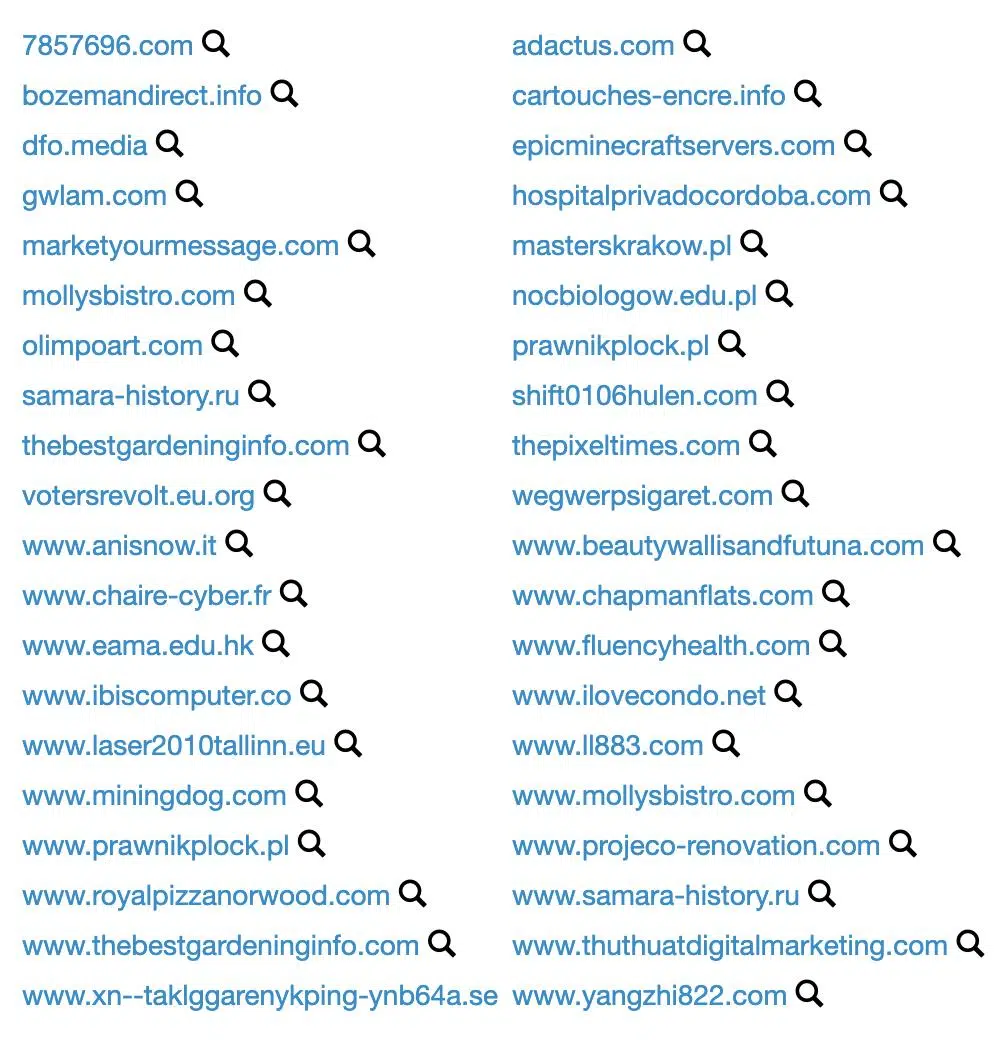
For the record, that link has two IP addresses, each shared by less than a hundred other links. While not a problem per se (sharing IP addresses is common), Google may show content from only one of these websites. Worst-case scenario, Google may drop the ranking of the primary website, just as it did to JCPenney after the discovery.
Aside from IP addresses, here’s some other red flags:
- High Domain Rating (DR) but low URL Rating (UR). There’s a high likelihood that the website’s unusually high DR comes from old backlinks. The low UR implies that it hasn’t uploaded quality content for a while.

- Hidden WHOIS data. Website owners hide their WHOIS data for various reasons, legitimate or otherwise. Nevertheless, a website that doesn’t disclose its reason for doing so is possibly hiding something.
 Some exceptions exist, such as masking under the European Union’s General Data Protection Regulation (GDPR). They’re more legitimate because websites have to fulfil legal requirements. Their WHOIS data appear like this.
Some exceptions exist, such as masking under the European Union’s General Data Protection Regulation (GDPR). They’re more legitimate because websites have to fulfil legal requirements. Their WHOIS data appear like this.
- Low-effort web design and content. While some PBN sites are well-designed and contain decent content, others barely try to appear legitimate. The example below consists of this post and nothing else.
 Another issue with this example is that the keywords are all over the place. Google can consider this keyword spamming and will penalise the website.
Another issue with this example is that the keywords are all over the place. Google can consider this keyword spamming and will penalise the website.
- High Domain Rating (DR) but low URL Rating (UR). There’s a high likelihood that the website’s unusually high DR comes from old backlinks. The low UR implies that it hasn’t uploaded quality content for a while.
- 4. Link Cloaking. Cloaking is the bait-and-switch of black hat link building. It entails presenting one version of a website to search engines and another of the same site to visitors. You can already see the problem: cloaking’s essentially duping the search engine.While effective in its purpose, cloaking is complicated because it involves tinkering with the code. Since Google’s updates in the past, the practice has narrowed to a few methods, the most typical being user agent and IP-based cloaking.Case in point: in 2006, Google deindexed BMW’s German website for using a JavaScript-based cloaking technique. Modern algorithm updates have rendered this method outdated, but it’s worth knowing how this practice works. In his blog, Matt Cutts shows what the page www.bmw.de/bmw-neuwagen.html looks like when crawled.
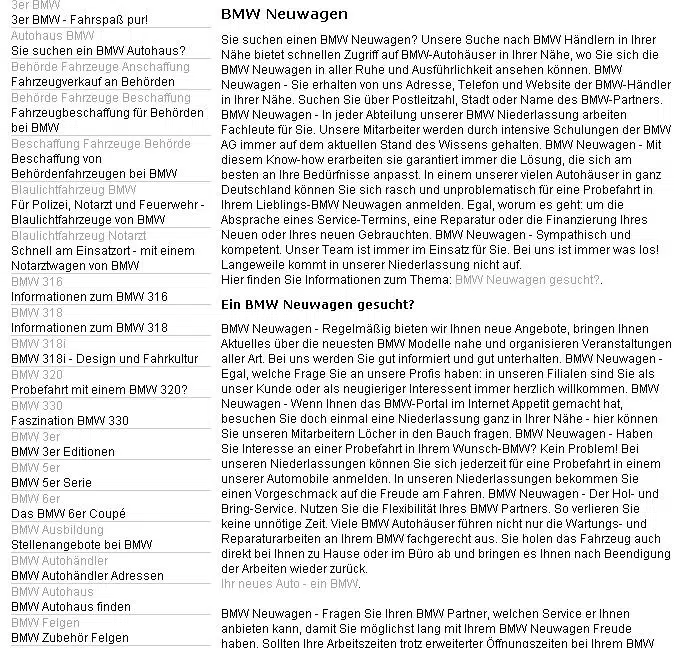
Here’s the same page but when viewed on a browser.
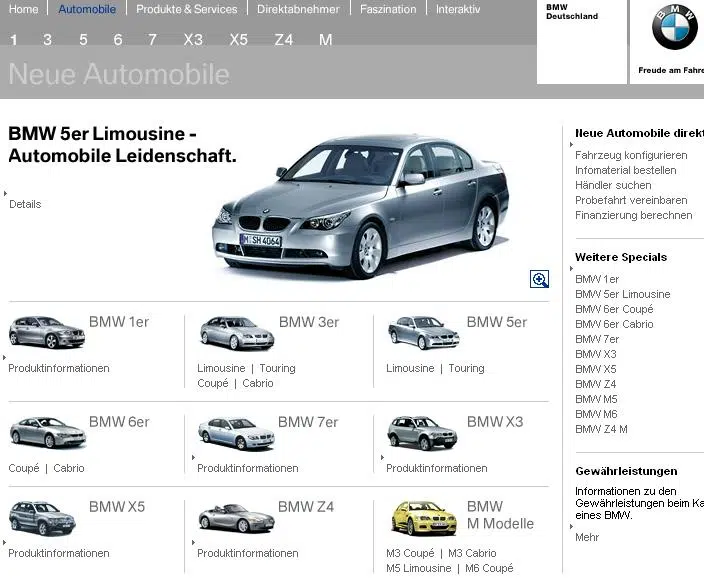
Cloaking isn’t just a violation of Google’s guidelines but also the basic principles of SEO. Even if the user version has more informative and unique content than the search engine version, it doesn’t eliminate the fact that a website engaged in deception. In the end, SEO exists for a users’ benefit, not search engines.
Even white hat cloaking can’t safeguard anyone from trouble. Google stresses the term itself is a contradiction and that it won’t make any exceptions on that front.
- 5. Comment Spam. Today’s comment sections are already troublesome enough, with people sharing their two cents and arguing against those of others. There’s absolutely no need for shameless web owners to flood discussion boards to promote their websites and earn backlinks like this one.
 If you’re going to say that you enjoyed one’s content, the least you can do is make the feeling genuine. If you have to add links to the comment, post one from a high-authority source and make sure it’s relevant.Comment spam for link building is, as one user on a forum commented, “a bit lame.” Internet users in this day and age know better. Users are even upset that web admins do little to prevent such comments from getting posted.
If you’re going to say that you enjoyed one’s content, the least you can do is make the feeling genuine. If you have to add links to the comment, post one from a high-authority source and make sure it’s relevant.Comment spam for link building is, as one user on a forum commented, “a bit lame.” Internet users in this day and age know better. Users are even upset that web admins do little to prevent such comments from getting posted.
On top of that, comment spam has been ineffective as a link building tactic for years. The nofollow tag, introduced in 2005, blocks comment spam by discrediting a link when Google ranks websites. While not necessarily vouching for the website’s dubiousness, the tag ensures commenters can’t abuse this black hat practice.
That same year, Google rolled out two attributes—User Generated Content (UGC) and sponsored—to check backlink quality further. UGC is useful for domains to allow guest posting and commenting.
- 6. Black Hat Redirects Most domains can last for up to ten years before web admins have to renew them to keep them active. Otherwise, they end up like this.
 If the website owner elects not to renew the domain (usually within a few months), it goes up for grabs. The original owner can still try to regain it but will need to act fast. Some will try to buy that domain as part of a black hat practice that involves 301 redirects.
If the website owner elects not to renew the domain (usually within a few months), it goes up for grabs. The original owner can still try to regain it but will need to act fast. Some will try to buy that domain as part of a black hat practice that involves 301 redirects.
For the record, a 301 redirect isn’t a black hat practice. It lets the search engine know that the website has moved to a new one, prompting it to transfer ranking data to the new site. It also forwards users who visit the old site to the new one. 301 redirects are an indispensable aspect of quality SEO.
However, 301 redirects are prone to abuse, which is where the black hat side comes in. By buying expired domains with backlinks from high-authority websites, website owners can set up the domains to backlink to the new target site. Due to the quality backlinks the expired domains have, the new website they’re being redirected to may benefit from increased rankings in SERPs.
Another way of abusing redirects is by hiding pages that are chock full of spam or have low-quality content. It’s like cloaking to an extent.
Do Link Building Right
Proper link building is neither easy nor quick. It takes time for the methods to complete, let alone take effect across the board.
Black hat link building may give businesses the edge it needs online. But if even big names get penalized after getting caught, small players will definitely be no exception. The updates Google has undergone over the decade have made black hat link building risky to the point that it isn’t worth doing anymore.
Play by the link building rules to prevent your SEO strategy from falling apart.
Contact us today if you want to do link building the right way.
Subscribe to Our Blog
Stay up to date with the latest marketing, sales, service tips and news.
Sign Up
"*" indicates required fields


